One Year Later: Puerto Rico’s Hurricane Recovery Efforts Continue
While the island has made great strides, it’s still recovering from the aftermath of Hurricane Maria, which made landfall in September 2017.

One year ago, Hurricane Maria made landfall in Puerto Rico, leaving the island in a state of devastation and its residents with lack of access to electricity, safe and travelable roadways, shelter and basic necessities like clean water and food.
The storm took the lives of approximately 2,975 people, according to Puerto Rico Governor Ricardo Rossello, who recently told CNNthat "this is unprecedented devastation. This number can change. It could be less, it could be more, as time passes."
As the island worked through its hardships following the storm, communities from all over the island, and the world, came together. There was cleanup to be done, electricity to be restored, homes and businesses to be rebuilt, etc. And to help the island overcome those challenges and get back on its feet, members of the waste and recycling industry flocked from all areas of the world to assist with cleanup and relief efforts.
The City of New York Department of Sanitation (DSNY), for example, assembled a team of 31 employees who assisted with relief and cleanup efforts for a total of 23 days. And Stericycle, a compliance company that specializes in collecting and disposing regulated substances, such as medical waste and sharps, pharmaceuticals and hazardous waste, assigned a team to help safely remove hazardous waste materials from the island.
As we look back at the year Puerto Rico has had following Hurricane Maria, we recap the planning and cleanup efforts, the strides made and the challenges that still linger.
Pre- and Post-storm Planning and Cleanup
In preparation for the storm, local waste and recycling companies worked to secure equipment, plan for an uptick in materials received at landfills and transfer stations, communicate with employees so they were aware of storm procedures and touch base with customers so they were informed of any delays in collection services.
One of the companies servicing the island, EC Waste, which provides waste management services to more than 100,000 residential customers, 3,500 business customers and approximately 1,000 industrial customers in Puerto Rico, created and followed an effective operational plan that allowed the company to restore services quickly and secure employee distribution through the aftermath of the disaster.
“Because of our plan, we were back up and running within 48 hours of the storm. We were fully staffed and ready to rock and roll with 297 of our 300 employees,” says Randy Jensen, CEO and president of EC Waste.
One of the things the company does to ensure its staff is safe and ready to work on cleanup efforts following any natural disaster is stock up on fuel, food and water before a storm is expected to make landfall. This effort helps ensure that staff has a ride to and from work and that they remain hydrated and nutritiously powered throughout the cleanup efforts.
As far as equipment goes, EC Waste typically shuts down its operations 12 hours before a storm is expected to make landfall so that it can move its equipment to higher ground or a secure location.
“We have an identified spot on our property where we can position our larger trucks and equipment in a circle and place the smaller, more vulnerable equipment inside that circle,” explains Jensen. “The arrangement looks like a garbage truck flower, and it really helps protect our equipment during a storm. You can never really predict when a storm will actually hit, but we take the gamble on experiencing some downtime to ensure that we are prepared. We would rather be overprepared than not prepared enough.”
After Hurricane Maria passed and it was safe to get back to work, the employees of EC Waste began their cleanup efforts by clearing the roads of any debris, so that the trucks could operate on their normal routes. Then, EC Waste partnered with the mayors of Humacao and Caguas to create drop points where residents could drop off their materials instead of waiting for collection services.
In addition, the company made immediate damage assessments to its landfills and transfer stations, and after noting that the damages were minor, it began operations at these facilities a few days after Hurricane Maria made landfall.
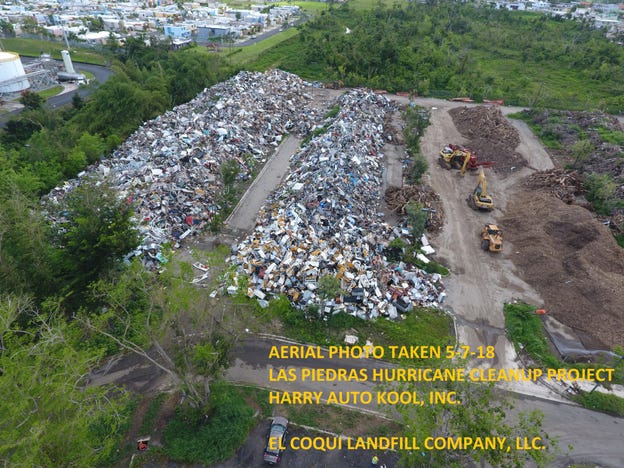
“All of our facilities have backup generators, and going forward, we plan to have a backup to a backup of our standard system to keep our facilities running smoothly after storms,” says Jensen. “While we did suffer some downtime and setbacks due to our backup power systems, we were able to get back up and running in a short period of time. In addition to adding another backup system, we are looking into solar and renewable energy options, so we can depend less on the grid and more on ourselves from a power perspective.”
At its two landfills, El Coqui and Peñuelas Valley, EC Waste accepted raw, vegetative storm debris and worked hand-in-hand with the U.S. Army Corps of Engineers and others to consolidate, store and eventually grind the material into mulch. EC Waste then utilized a large portion (about 3.5 million cubic yards) of that mulch for roadways, erosion control on slopes, daily cover and promoting vegetative growth.
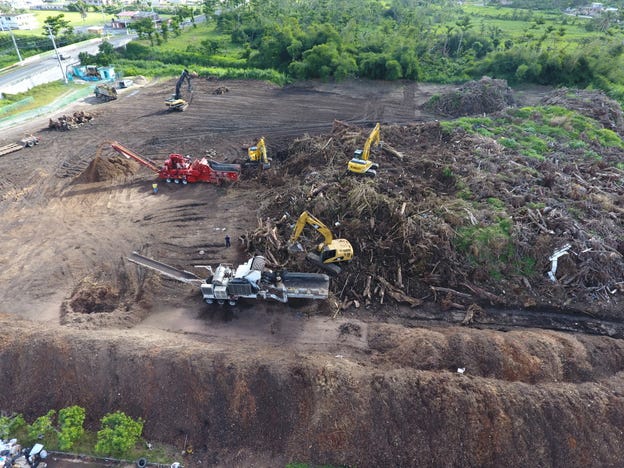
According to the company, at the peak of the cleanup process, it received more than 200 trucks daily with debris.
EC Waste also had staging areas on its properties for construction and demolition (C&D) materials. The company worked to remove any steel or ferrous metals from that debris, and then recycled those metals via local scrap yards. By doing this, EC Waste reduced the C&D debris by about 50 percent, ultimately using less airspace.
To manage the extra volume in materials without affecting the airspace availability projections, EC Waste made new investments in its Subtitle D-compliant landfills to improve operations and achieve efficiencies. As part of these investments, the company recently started construction of a new waste disposal cell at its El Coqui landfill. It has also invested capital that secures available airspace in the long term, ultimately providing Puerto Rico with safe and compliant disposal for more than 40 years.
“Industry estimates reveal that the recent disasters generated an estimated 6 million to 12 million yards of debris in Puerto Rico, which once are reduced will equal to approximately one year of the total island airspace available for waste disposal,” states EC Waste.
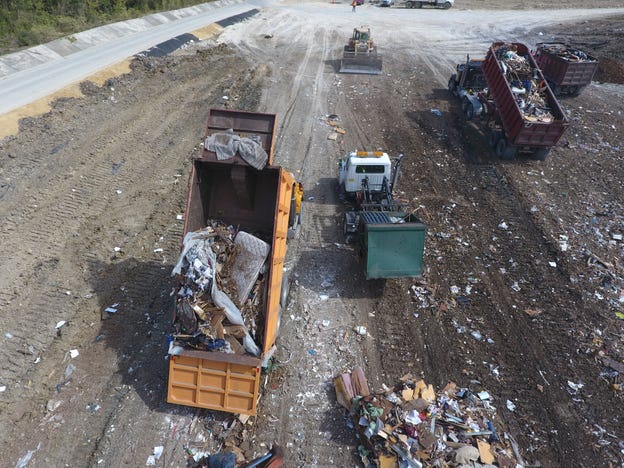
Identifying Areas in Need of Assistance
With many forms of communication, such as phone, internet and radio, unavailable, cleanup crews relied on word of mouth and municipality visits to identify areas in need of assistance.
The DSNY cleanup crew, Puerto Rico Emergency Management (PREMA) 31, initially went to Puerto Rico to assist with debris removal and ended up taking more of a humanitarian management role due to lack of equipment and personnel.
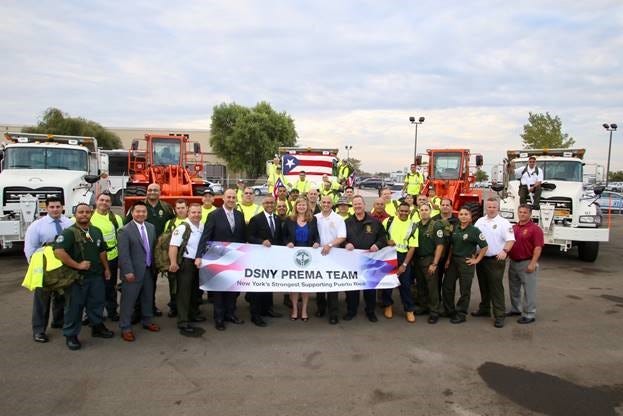
“Our team assisted 76 out of 78 municipalities, which was possible mainly due to our strength in numbers,” says DSNY Assistant Chief John Rossiello. “We were able to visit up to eight municipalities per day and come back to check up on municipalities to ensure that they received what they needed.”
The main necessity that people lacked during the aftermath of the storm was clean drinking water. A lot of the water stations on the island are run by electricity, so if electricity wasn’t available, water wasn’t available. People were also in need of blue tarps for damaged roofs, food and generators.
“We were able to address and manage the needs of municipalities by communicating well and holding daily meetings,” says DSNY Supervisor Lisa Cabrera. “I was proud of our team for stepping in wherever help was needed, and I was really moved by the amount of tears that grown men shed on our trip. Everyone was emotional; it didn’t matter if you had ties to people in Puerto Rico or not.”
Aside from assisting with humanitarian management, DSNY staff helped the U.S. Army Corps of Engineers and municipalities create short dumps, which is a process that DSNY followed during Hurricane Sandy.
“Landfills were overcrowded due to the uptick in organic debris, flooding and people virtually throwing out their whole house, so we assisted with turning large fields and parks into short dumps,” comments Rossiello. “Short dumps serve as a holding place for materials until landfills are ready to accept more loads, and you really only need a pen and paper to keep track of the inventory coming to and leaving these temporary sites.”
Despite the lack of equipment and personnel, the cleanup crews and local companies made do with the resources available and worked around the clock to manage the waste and debris that piled up in each municipality.
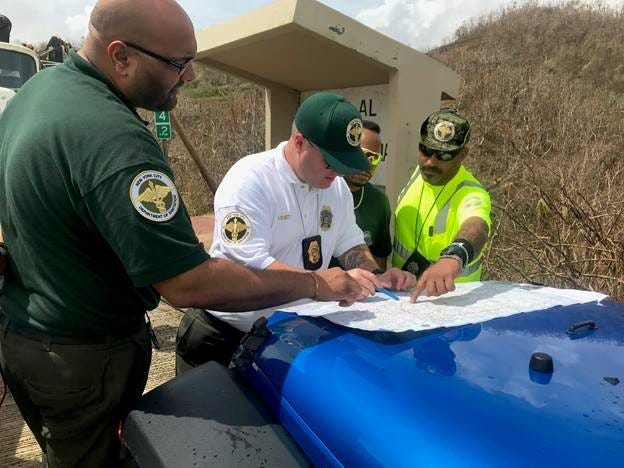
In Puerto Rico, each individual municipality is responsible for providing waste collection services, be it as a public entity or by way of subcontracts. And not having contingency plans for the collection and management of debris created by a natural disaster can cause many challenges and confusion.
“There is certainly a need or opportunity to properly require municipalities to not only update or ensure proper implementation of their emergency plans or rather, more importantly, contingency plans but also to integrate debris management details in such documents,” says Hanna Rodriguez-Morales, international board representative for the Solid Waste Association of North America’s (SWANA) Caribbean-PR Chapter. “As an engineer, I am trained to think about contingencies or backups in any case, but as a citizen of Puerto Rico, I’m aware of the limited economic resources of municipalities. This is where the challenge lies for us millennials or young professionals, particularly on an island where its workforce has recently worked more with limited economic resources.”
To assist with working through this challenge and to provide on-the-ground relief assistance and education, the SWANA Caribbean-PR Chapter and its members joined forces with the National Disasters Assistance Commission and the Humacao Chapter of the College of Engineers and Land surveyors to conduct community-based initiatives and to hand out provisions during the initial response phase.
The groups hope that their efforts will encourage municipalities to create more effective and efficient emergency and contingency plans to abide by in the future.
Managing Hazardous Waste Materials
In addition to managing storm debris and waste, companies had to properly and safely secure and remove hazardous waste materials from the island. Stericycle, which services Puerto Rico on a regular basis, stepped up to help its retail customers with the handling, securing and removal of hazardous waste materials.
“About two weeks after Hurricane Maria hit, and for months after, our personnel were on the ground helping with recovery,” says Maricha Ellis, vice president of sales and marketing operations for Stericycle. “One of the biggest challenges for us after this storm, and any storm really, is that everything looks like waste. While it’s all trash, it needs to be properly segregated and disposed of to avoid any health and safety hazards.”
To manage the hazardous waste, Stericycle staff filled large drums with hazardous waste, and a transporter moved that waste to a port, which was damaged and backed up with shipments. Those challenges made it difficult for the company to remove the waste from the island and dispose of it properly in a timely manner. Despite those challenges, Stericycle worked to transport the hazardous waste from the island to the port of Jacksonville, Fla. From there, it was sent to Birmingham, Ala. That was a bottleneck for the company, but most of the non-hazardous waste was landfilled on the island in a pretty simple process, according to Stericycle.
“The overall conditions on the island were very poor—roads were damaged, there was little to no power, phone coverage was scarce, clean and drinkable water was hard to come by and basic supplies were extremely low,” states Ellis. “Our primary objective was to remove hazardous waste materials like flammable products, pharmaceuticals and damaged toxics and goods from the island, but the obstacles at the port and the fact that we had to have all of our supplies shipped over via cargo boat made things very difficult.”
Stericycle worked to overcome its challenges, and through its cleanup efforts, the company locally disposed of 10 roll-off containers of 40 cubic yards. The containers averaged around 15,000 pounds each and contained nonregulated material.
“I think an unfortunate positive consequence of Hurricane Maria has been that we’ve seen more customers take an active role in preparing for emergency situations,” comments Ellis. “More and more customers want to have a plan in place and want to know how to properly segregate and elevate their hazardous waste ahead of natural disasters. We are here to help them with that, and we are here to educate companies on other best practices for handling hazardous waste.”
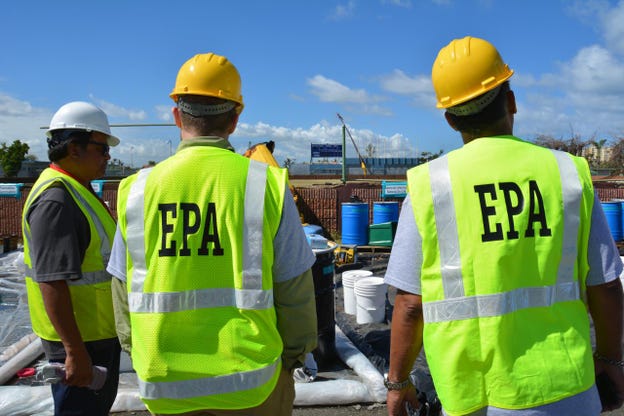
The U.S. Environmental Protection Agency (EPA), along with the U.S. Army Corps of Engineers, the government of Puerto Rico and municipalities, also played a large role in collecting household hazardous waste. As of information released in April, the EPA collected nearly one quarter of a million items via household hazardous waste collection services and special one-day collection events.
“The EPA’s work is transitioning from immediate response to long-term recovery, and our household hazardous waste program throughout Puerto Rico has helped many people properly dispose of potentially hazardous items they may have stored in their homes,” said EPA Regional Administrator Pete Lopez in a statement. “The success of this program is a good illustration of the importance of cooperation and coordination in all levels of government to work toward a common goal: protecting the health of the people of Puerto Rico.”
Current State of the Island and Ongoing Challenges
While Puerto Rico has made great strides, the island is still recovering from the aftermath of Hurricane Maria. Many residents and businesses still only have power via generators, many homes and businesses still need repairs and many areas are still low on basic supplies and necessities.
“There were some really dark days, but I can say now that Puerto Rico is looking pretty bright,” says Jensen. “It’s amazing what a little bit of light can do, and even if some of this power is temporary, it’s a solution for now, and it’s making our days a lot less dim.”
Though the power has been restored on the island temporarily and some homes and businesses have been repaired, Puerto Rico is in dire need of skilled labor to help get the island back to a normal state.
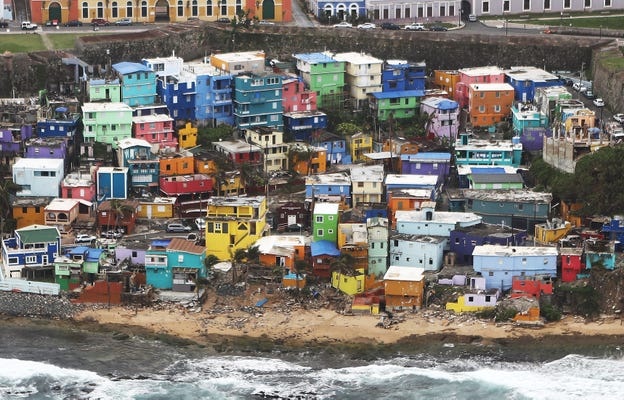
“One of the biggest things we still need help with is building infrastructure and labor,” states Jensen. “Puerto Rico doesn’t have enough construction workers to get us rebuilt fast enough, and it doesn’t have enough electricians to get the island’s power back up and running properly. Honestly, when it comes to those two things, we need all the help we can get.”
In addition to building infrastructure, Jensen stresses that the federal and local governments need to step it up when it comes to closing illegal dumps and improving the island’s waste management system, so that waste is always being handled by a compliant landfill opposed to an illegal dump.
“As an island, we still have a lot to learn,” says Jensen. “Throughout my career, I’ve realized that experiences like this help you identify what your weaknesses are and what areas you need to strengthen. In Puerto Rico, we still have a lot of noncompliant dumps struggling to operate, and I hope that the federal and local governments can figure out a good plan to close these illegal dumps and improve the waste management system by securing investment for the development of more compliant landfills.”
Waste360 will continue following the news coming out of Puerto Rico. We encourage our readers to email Editorial Director Mallory Szczepanski at [email protected] with any updates or information you may have on the island’s recovery efforts.
About the Author
You May Also Like




